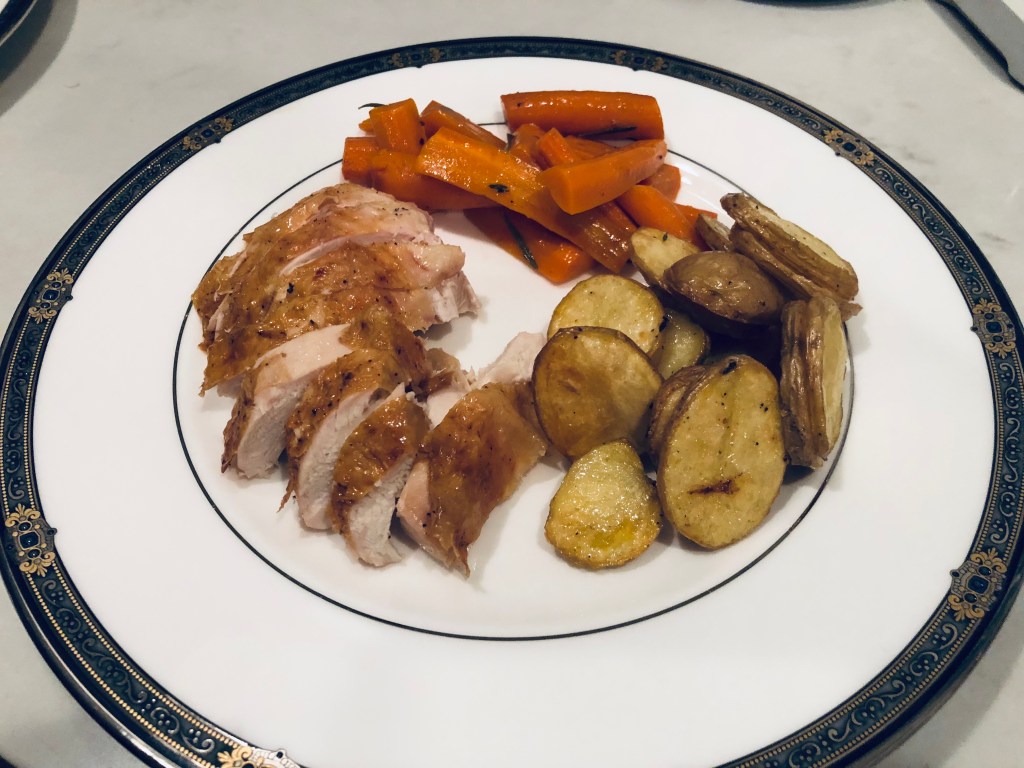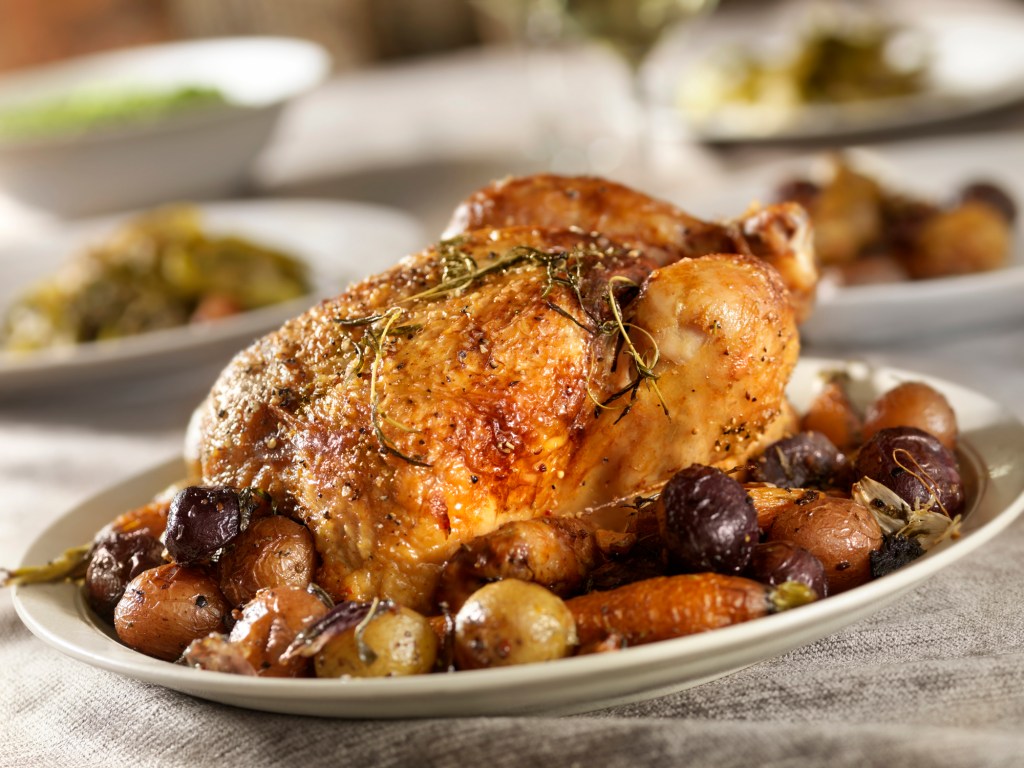With inspiration from Ina Garten, a little improvisation, and inspired white wines, this will become a staple recipe in your house.
A few years ago, I stumbled across my favorite roast chicken recipe. And in the intervening years, I’ve improvised only slightly, adding a few ingredients, a side-dish of roasted potatoes, and a decadent beurre blanc sauce for finishing.
The original recipe is Ina Garten’s Perfect Roast Chicken, and in the instructions below, I explain the subtle deviations from her perfect process, along with how to prepare the potatoes and beurre blanc sauce.
This roast chicken dish has become so popular with my wife and daughter, that it has been requested almost weekly for over a year, affording me ample experimentation with wine. I have happily discovered that my all-time favorite wine pairing (and companion for the white wine sauce) is Chalk Hill Chardonnay—both the Sonoma Coast bottling and the Estate Bottled Chalk Hill Appellation label.
And I can’t decide which one I prefer. So, sometimes, I’ll open both. The Sonoma Coast style is a little brighter and tropical-fruit driven, while the Estate Bottled is richer, unfiltered, with stone and orchard fruit notes. I love them both. For the beurre blanc sauce, the Sonoma Coast style offers a slightly brighter, zippier sauce, while the Estate Bottled yields a richer, heartier sauce. My advice? Try it both ways. Ready?
Preparation Time: 20-30 minutes.
Cooking Time: 1 hour, 30 minutes.

Ingredient List:
Note: If you are able to source all the ingredients locally, especially from a Farmer’s Market — including the chicken — you will find that this dish just shines. Store-bought ingredients are just fine as well, as long as they are as fresh as possible, organically or sustainably-farmed, and from as close to locally-sourced as possible.
1 bottle of Chalk Hill Sonoma Coast Chardonnay, or,
1 bottle of Chalk Hill Estate Bottled Chalk Hill Appellation Chardonnay (or both!)
1 roasting chicken (4-6 lbs)
Coarse Kosher salt
Maldon finishing salt
Freshly ground black pepper (from a pepper mill if possible)
1 large bunch of fresh thyme sprigs, separated
1 large bunch of fresh rosemary sprigs, separated
1 lemon, halved
1 head of garlic, cut in half crosswise (optional)
3-4 tablespoons unsalted butter
1-2 medium size sweet yellow onions, quartered
1-2 shallots or small red onions, quartered
6 carrots, halved, and cut into 1-2 inch chunks
1 lb of fingerling or small round baking potatoes (red, purple, white, or a mix, you decide)
Just under half a cup of white wine (for beurre blanc sauce)
Olive oil
Meat thermometer, set of tongs, a fine mesh strainer, large and small stainless steel bowls

For cooking, a cast-iron pan is recommended, though any over-proof pan of similar size will work. Additionally, a baking dish will work too, but you’ll have to transfer the juices at the end to a frying pan to make the beurre blanc sauce. My favorite pan in the world is this cast-iron pan from Smithey. It’s the first (and last) cast-iron pan you’ll need in this lifetime.

Directions:
1. Preheat the oven to 425 degrees F.
2. Remove the chicken giblets. Rinse the chicken inside and out. Pat it dry, then place on a plate and put back in the refrigerator for now.
3. Prepare the vegetables. Quarter the onions and shallots. Peel and slice the carrots lengthwise and then cut them into 1-2 inch pieces. Toss the onions, shallots, and carrots in a bowl with a couple good glugs of excellent extra virgin olive oil, 3-4 sprigs each of the thyme and rosemary, and season well with salt and pepper. Toss to coat, making sure the olive oil coats every piece of onion and carrot as well as the herbs. Pour into your pan.
4. Retrieve the chicken from the fridge and drop it right on top of the veggies in the pan. Sprinkle a generous amount of Coarse Kosher Salt into the cavity and nestle the bird into the veggies half an inch or so, and tuck the wing tips under the body, but — DO NOT tie the legs. Ina Garten suggests tying them, as do most recipes, but this is one of my improvisations that I find evenly cooks the darker meat to perfection.
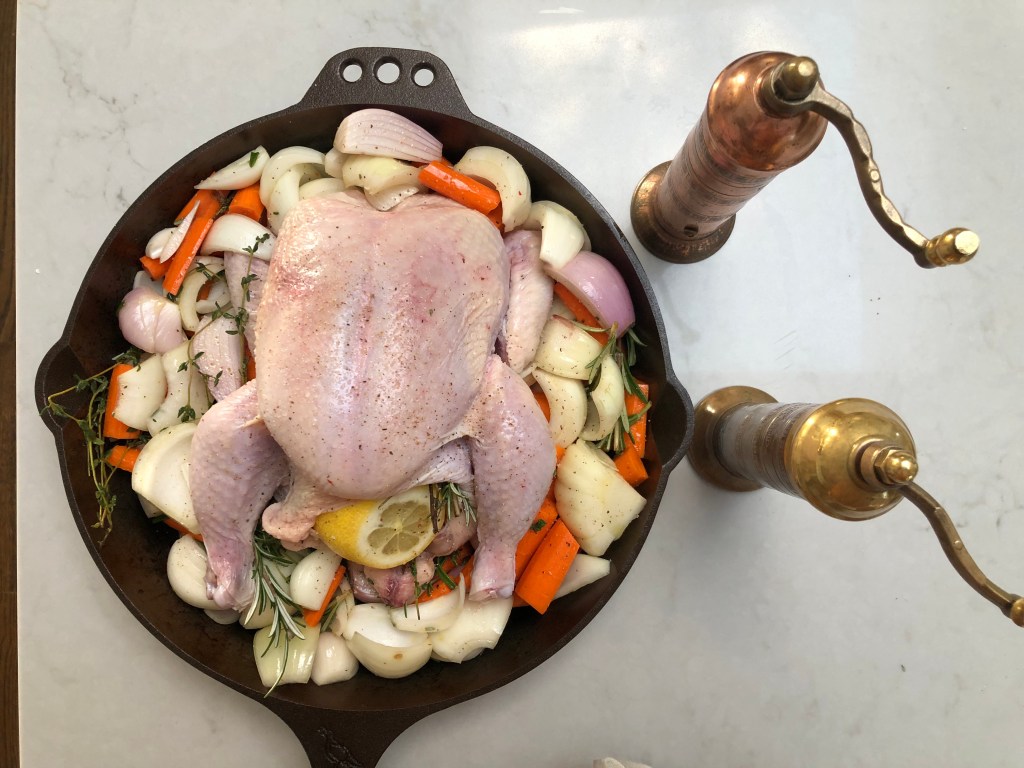
5. Stuff the cavity with the remaining thyme, rosemary, and both halves of the lemon. I like to insert one half of the lemon first, and book-end the herbs with the other half. Ina’s recipe calls for adding garlic, which you are more than welcome to do. Sometimes I do, sometimes I don’t. The garlic will add dimension to your beurre blanc sauce.
6. Melt 1-2 tablespoons of unsalted butter and brush over the chicken. Season with salt and pepper and roast in the oven on the top rack for 1hr and 10 minutes, up to 1hr and 30 minutes, depending on the size of the chicken. Just make sure the juices run clear and a thermometer reads 162-165 degrees when you take it out. Note: you do not need to rotate during cooking.

7. While the chicken begins roasting, prepare the potatoes. Cut them into quarter-inch-thick slices as pictured above. Toss with olive oil, salt and pepper and lay each potato evenly and flat out on a baking sheet, pictured below.
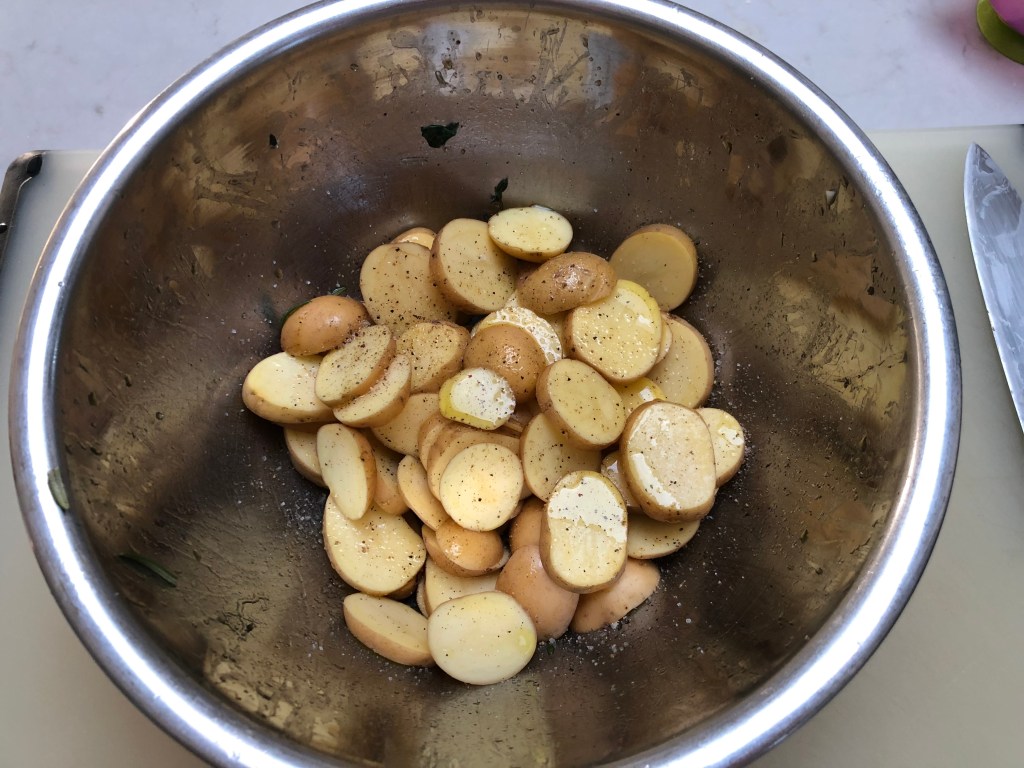

8. Place on the bottom rack and set the timer for 25 minutes. Don’t touch the potatoes until then! Don’t flip ‘em. Nothing. Let ‘em cook.

9. Time for some wine! Retrieve your wines from the fridge! Ideally, you’ve kept your Chardonnay in a wine cellar, and popped the bottles in the refrigerator as you began prepping the veggies. With this advance planning, the wine is the perfect temperature—not frigid-cold as to mute the aromas and flavors, but with a perfect chill.
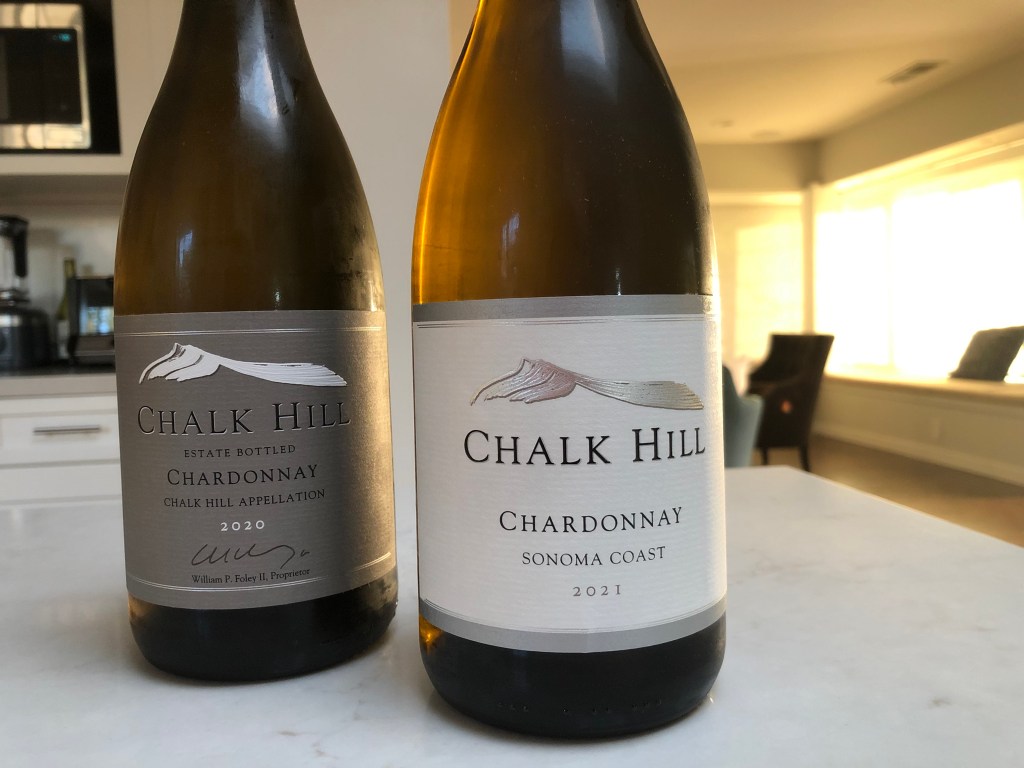
10. After enjoying a glass (or two), your potatoes should be ready. When that 25-minute timer goes off, pull them out of the oven. You’re looking for a crisp outside and a tender inside. The side of the potatoes in contact with the pan should have a lightly golden-brown hue while the tops are still light, but the skins are visibly crisped, even slightly puffed. Let one cool for a minute and then taste. Pop them back in for 3-5 minute intervals to achieve your desired crisp level. Once you’re happy with the texture, set on the stovetop so the radiant heat keeps them warm. Set aside if the heat is too intense.


11. Once the chicken reaches 165 degrees F in the breast meat, or around 162 F in the thigh meat, remove from the oven. Let it rest on the oven top for 10 minutes.
12. After 10 minutes, using a set of tongs, remove the lemon from the cavity, but squeeze its hot juice into the pan. Discard the herbs. Tilt the chicken and cut slits in between the body and the thigh to let any juices run into the pan. Once you’ve let all the juice run into the pan, set the chicken aside on a carving board — no need to cover. Discard the onions and shallots (or set them aside and serve them as well if you prefer). Set aside the carrots for serving. You should be left with just the juices, herbs, and bits.
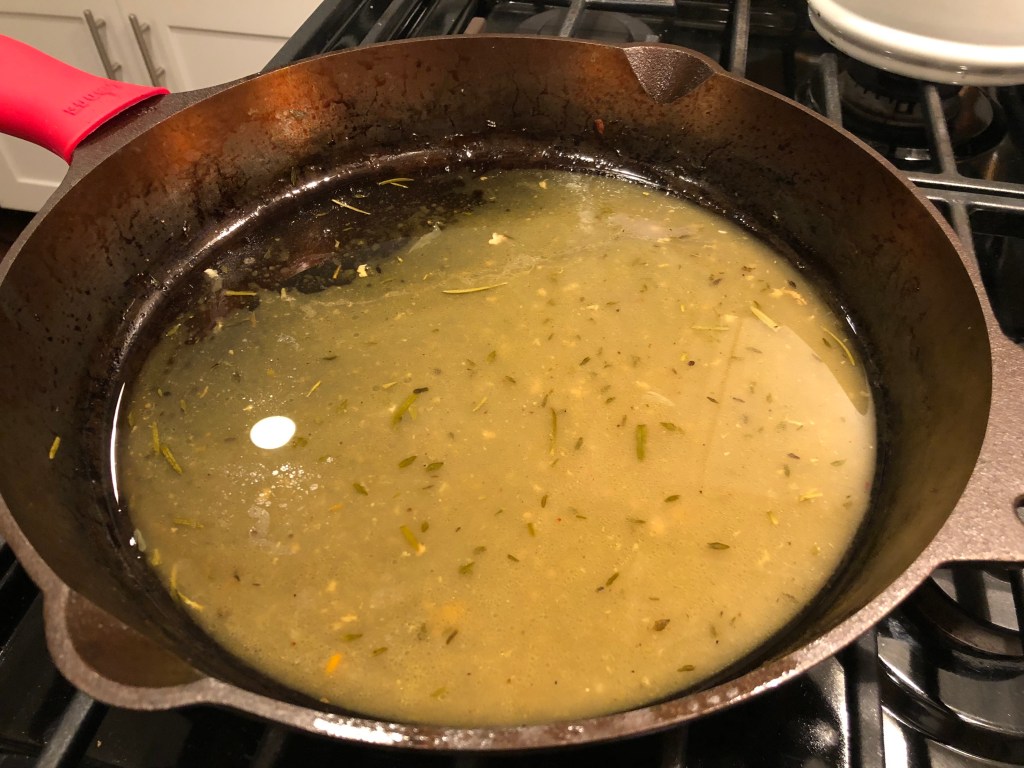

13. Prepare the Beurre Blanc sauce! I like to let the sauce sit for another 5-10 minutes as some of the fat from the chicken forms a thin layer on top, which you can then skim off with a spoon. Now, crank up the heat to medium-high and bring to a boil, scraping up the bits. After about 2-3 minutes, pour in just under half a cup of white wine, continue stirring, and scraping up bits and allow the sauce to reduce by half. Once you think you’ve got it there, remove from the heat and stir in 1-2 tablespoons of unsalted butter. Being careful, pour through a fine-mesh strainer into a bowl, then into a serving vessel. You’ll be left with about one-half or three-quarters of a cup.
14. Time to plate! I like to fully carve the chicken, removing the bones from the breast meat and slicing it before plating. Nestle in a handful of potatoes, a good portion of the carrots, and drizzle some sauce over the chicken before serving and bring the remaining sauce to the table and pass it around — that’s liquid gold! Speaking of, offer up your best Chardonnay toast, and enjoy!

